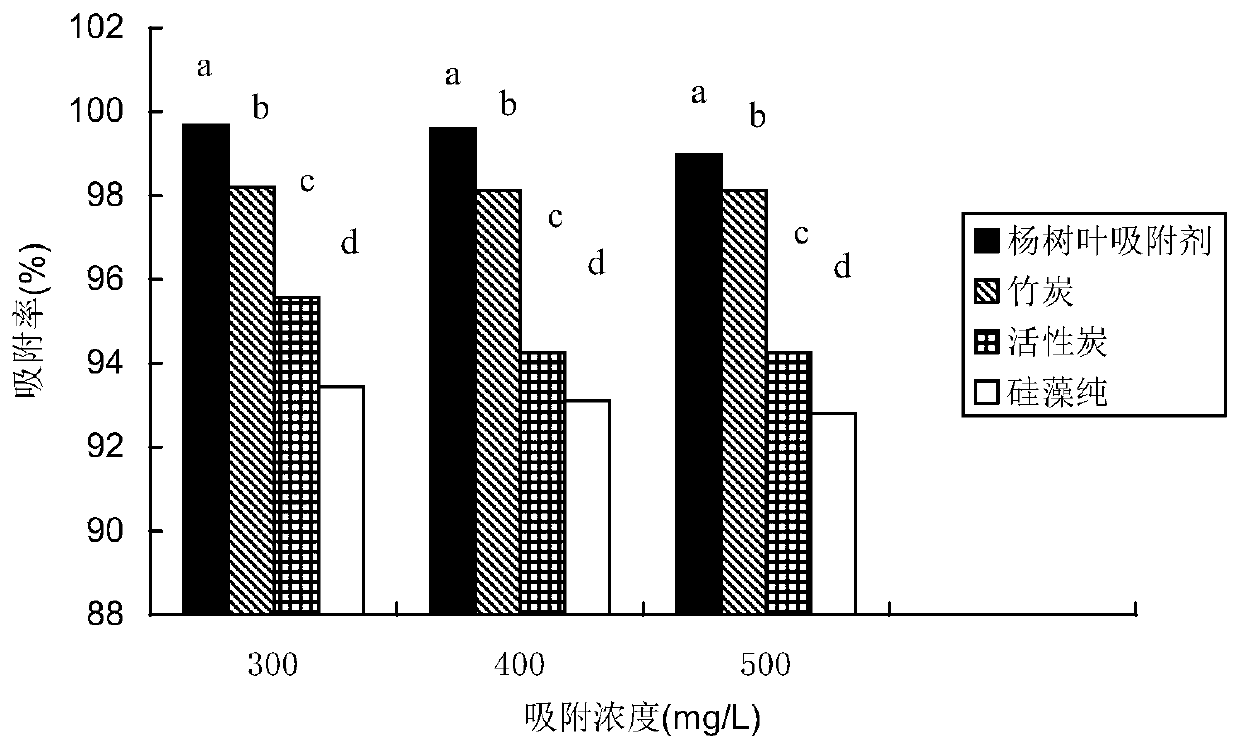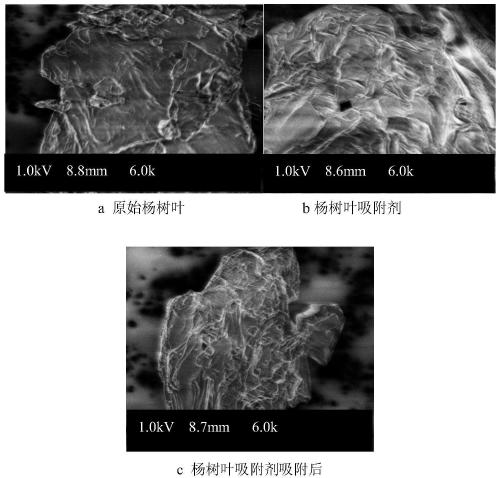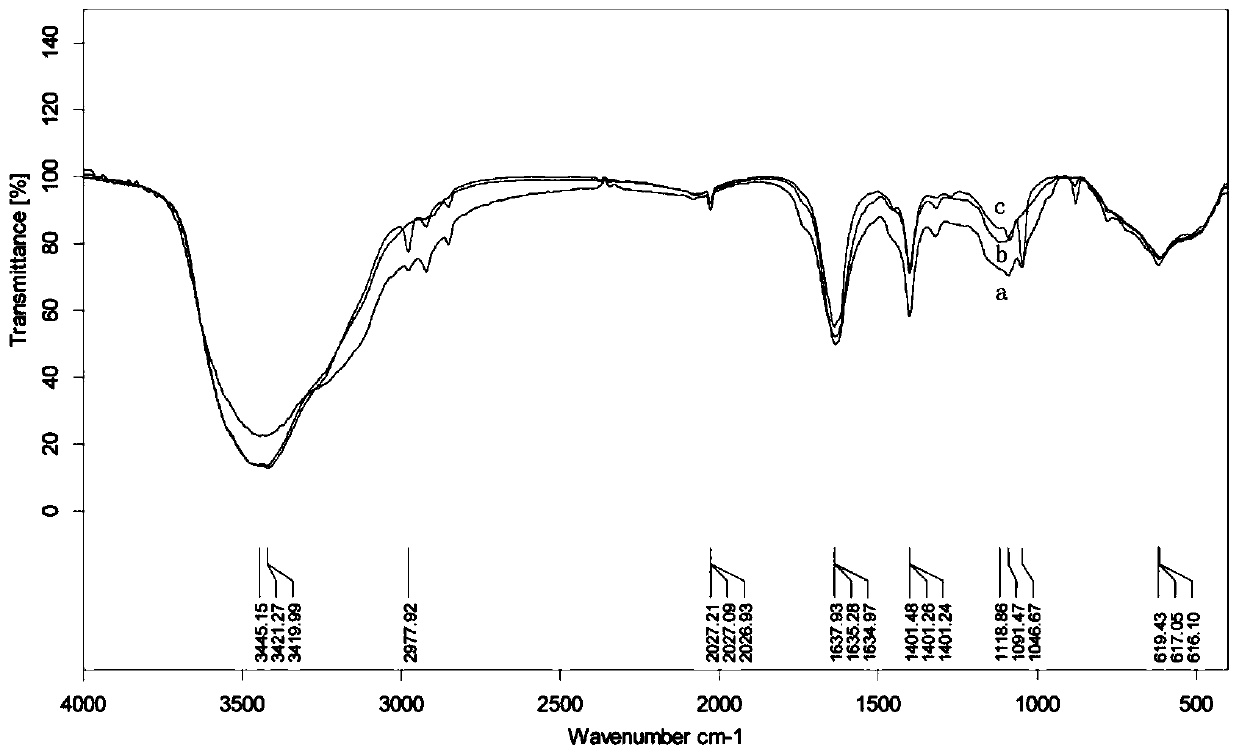Preparation method of biological adsorbent for treating basic fuchsin in printing and dyeing wastewater
A biosorbent, printing and dyeing wastewater technology, applied in the direction of chemical instruments and methods, adsorption water/sewage treatment, other chemical processes, etc., can solve the problems of poor removal effect, secondary pollution, etc., to achieve the reuse of waste resources, realize The Effect of Economic Circular Development and Environmental Protection
- Summary
- Abstract
- Description
- Claims
- Application Information
AI Technical Summary
Problems solved by technology
Method used
Image
Examples
Embodiment 1
[0026] A kind of preparation method of the biosorbent for treating basic fuchsin in the printing and dyeing wastewater in the present embodiment, its specific steps are as follows:
[0027] 1) Washing: After cleaning the poplar leaves, cut them into 4 cm pieces and soak them in distilled water for 20 minutes;
[0028] 2) Drying: Place the above-mentioned cleaned poplar leaves in a constant temperature drying oven at 70°C and 6.67×10 Pa to dry to constant weight;
[0029] 3) Soaking in hydrochloric acid: put the poplar leaves baked to constant weight into the hydrochloric acid solution of pH=1, and completely soak the poplar leaves for 2 hours;
[0030] 4) Ultrasonic hydrolysis: put the poplar leaves soaked in hydrochloric acid into an ultrasonic instrument for hydrolysis, the ultrasonic power is 200W, the temperature is 70°C, and the time is 10min;
[0031] 5) Salting out: Rinse the ultrasonically treated poplar leaves with distilled water for 3-5 times, then add the filtered...
Embodiment 2
[0071] A kind of preparation method of the biosorbent for treating basic fuchsin in the printing and dyeing wastewater in the present embodiment, its specific steps are as follows:
[0072] 1) Washing: After cleaning the poplar leaves, cut them into 5 cm pieces and soak them in distilled water for 40 minutes;
[0073] 2) Drying: Place the above-mentioned cleaned poplar leaves in a constant temperature drying oven at 80° C. and 6.67×10 Pa to dry to constant weight;
[0074] 3) Soaking in hydrochloric acid: put the poplar leaves baked to constant weight into a hydrochloric acid solution of pH=2, and soak the poplar leaves for 3 hours;
[0075] 4) Ultrasonic hydrolysis: put the poplar leaves soaked in hydrochloric acid into an ultrasonic instrument for hydrolysis, the ultrasonic power is 200W, the temperature is 70°C, and the time is 20min;
[0076] 5) Salting-out: Rinse the ultrasonically treated poplar leaves with distilled water for 3-5 times, then add the filtered poplar lea...
Embodiment 3
[0082] A kind of preparation method of the biosorbent for treating basic fuchsin in the printing and dyeing wastewater in the present embodiment, its specific steps are as follows:
[0083] 1) Washing: After cleaning the poplar leaves, cut them into 2 cm pieces and soak them in distilled water for 10 minutes;
[0084] 2) Drying: Place the above-mentioned cleaned poplar leaves in a constant temperature drying oven at 60°C and 6.67×10 Pa to dry to constant weight;
[0085] 3) Soaking in hydrochloric acid: put the poplar leaves baked to constant weight into a hydrochloric acid solution with pH=0.5, and soak the poplar leaves for 1 hour;
[0086] 4) Ultrasonic hydrolysis: Put the poplar leaves soaked in hydrochloric acid into an ultrasonic instrument for hydrolysis, the ultrasonic power is 200W, the temperature is 70°C, and the time is 5min;
[0087] 5) Salting out: Rinse the ultrasonically treated poplar leaves with distilled water for 3-5 times, then add the filtered poplar lea...
PUM
| Property | Measurement | Unit |
|---|---|---|
| Concentration | aaaaa | aaaaa |
| Concentration | aaaaa | aaaaa |
| Concentration | aaaaa | aaaaa |
Abstract
Description
Claims
Application Information
 Login to View More
Login to View More - R&D
- Intellectual Property
- Life Sciences
- Materials
- Tech Scout
- Unparalleled Data Quality
- Higher Quality Content
- 60% Fewer Hallucinations
Browse by: Latest US Patents, China's latest patents, Technical Efficacy Thesaurus, Application Domain, Technology Topic, Popular Technical Reports.
© 2025 PatSnap. All rights reserved.Legal|Privacy policy|Modern Slavery Act Transparency Statement|Sitemap|About US| Contact US: help@patsnap.com



